Bavaria C38, Dufour 290, Hanse 388: Three cruising yachts in a living comparison
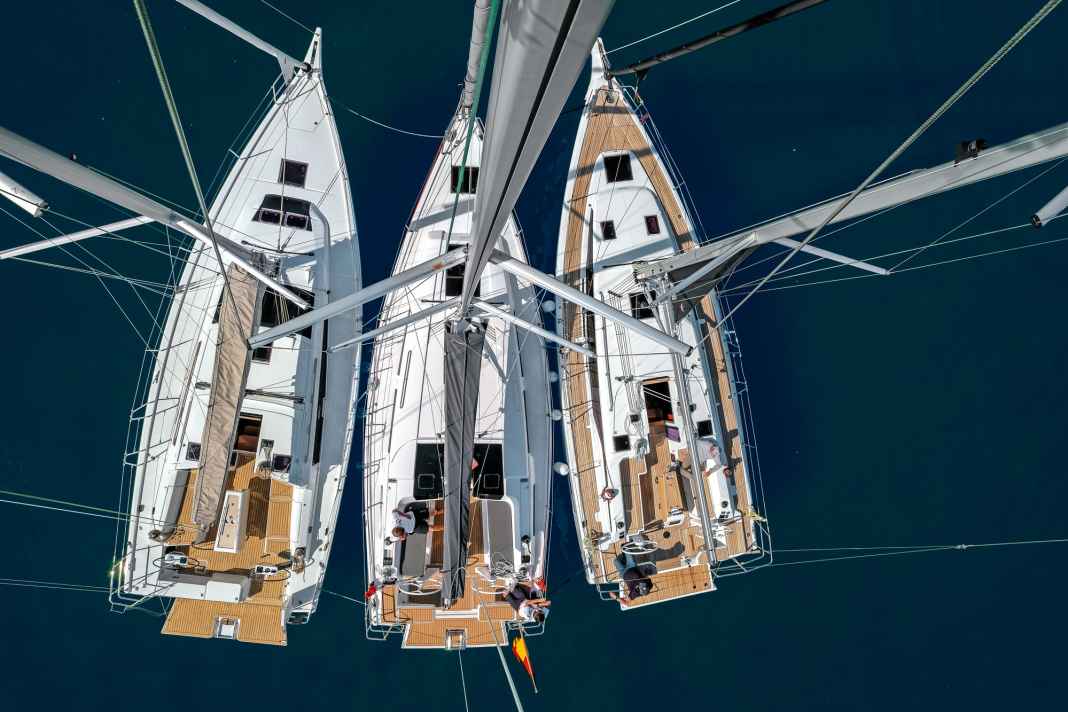





In this article:
After the tests under sail in the large collective test of cruising yachts around eleven metres hull length in summer 2021, none of the participants was able to establish a clear lead. Despite different rig and keel configurations, all three types in the group test showed a very comparable level of performance in Neustadt Bay.
The Dufour 370 has a very slight advantage, sailing strongly in all conditions, but especially in strong winds, despite her comparatively modest wardrobe; she is also convincing in terms of handling. The Frenchwoman therefore goes into the second round with a mini-bonus.
For the three class representatives, the freestyle is now followed by the compulsory test, which takes place in the harbour. In the Ancora Marina in Neustadt on the Baltic Sea, the YACHT test team subjects all the boats to an in-depth assessment, even beyond the companionway. The fact that the three test boats can lie side by side makes the procedure easier. The direct comparison from boat to boat reveals the most significant differences in terms of layout, utilisation and the feeling of space below deck.
The cruising yachts in the individual test:
The standard layout is identical
The standard layout is the same on all ships within the test group. This means: two double cabins aft, one double cabin forward, plus a toilet room aft, saloon, galley and a small navigation area - the usual arrangement in the eleven-metre tourer class. As already mentioned in the first part the boats turn out to be somewhat smaller versions of their larger sisters in the 40-foot class, i.e. with a hull length of twelve metres. This also essentially applies to the look below deck, the layouts and the variants. As an alternative, all three can be converted into twin cabins, each with a large aft locker, and a second toilet room is possible in the foredeck.
And Dufour can also offer an additional modification: The 390 is also available in a three-cabin version with three toilet compartments. In this case, the galley moves to the port side of the saloon as a long row instead of the second sofa. This variation is exclusive to the Frenchwoman within her class.
However, the ship is not often ordered in this version, according to the shipyard representatives, because the compromises at the expense of cosiness below deck are very drastic, even for use in yacht charters.
Hanse and Dufour are light and spacious, the Bavaria is a little obstructed
To assess the general impression of space below deck, the YACHT testers go from ship to ship. The Bavaria C36 pleases with a rather classic-looking, inviting mahogany interior, which corresponds to the standard. Optionally, the yacht builders in Giebelstadt also use light-coloured oak or walnut wood. Colour alternatives for the floor and upholstery extend the range of customisation options. In the direct comparison and also in the comparison of the layout plans, Bavaria gives less space to the central saloon. The seating area appears more compact, the galley comparatively oversized and the interior looks a little cramped. The dark-coloured wood and upholstery on the test boat contribute to this impression. Nevertheless, there is sufficient light in the Bavaria. The windows in the hull and in the cabin superstructure are larger than those of the competitors. They provide a lot of transparency.
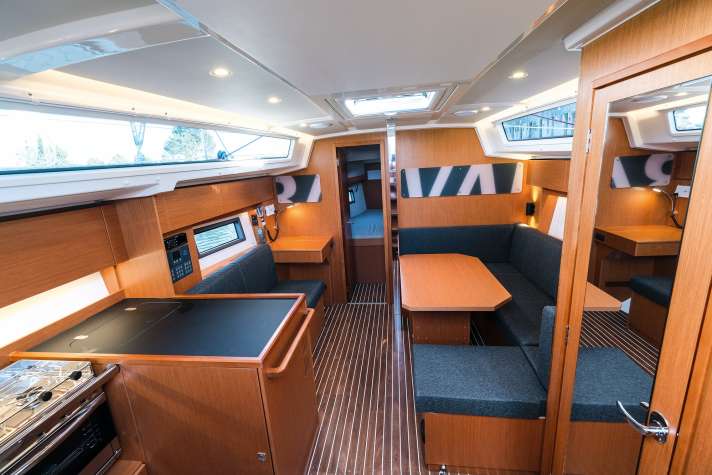
Light-coloured wood creates more perceived volume
When visiting the Dufour 390, the impression of space is different. With its light-coloured oak furniture, the Frenchwoman offers more perceived space below deck than the Bavaria. The saloon area here is more open, more spacious, and with the same hull width. Although the windows in the superstructure and hull of the Dufour are smaller, a lot of light enters through the large panoramic window in the cabin superstructure, making the ambience below deck bright and airy. Dufour offers options for the interior fittings with darker teak.
When it comes to cosiness, the Hanse 388 scores highly. Although she is somewhat slimmer than the Bavaria and Dufour boats, the impression of space is also open and generous, and the look is modern and contemporary. The Hanse also comes to the test with a light-coloured oak interior. Alternatively, darker colours are possible: mahogany (standard) or chestnut wood; numerous upholstery options are also available. The almost square hull windows provide light and visibility below deck, but are only beautiful from the inside.
In the group test, the assessment of the room impression in the living area is subject to personal perception in direct comparison. What some people perceive as beautiful and pleasant, others may not necessarily like. This must be taken into account at this point.
It gets cramped in some bunks
In contrast, the folding rule takes over for the evaluation of the berth dimensions. However, there is also a need for explanation within the test group: The Bavaria C38 is equipped with an additional toilet room in the foredeck, which significantly reduces the size of the berth (see below). In the standard version without a wet room in the bow, the yacht from Giebelstadt would have by far the largest and widest double berth in the class at the front, benefiting from its enormously voluminous bow section. The width would be 2.22 metres at shoulder height. In contrast, the width of the test boat with optional bathroom is only 1.47 metres.
Even on the Dufour, the bunk in the foredeck is more than two metres wide at shoulder height. Should the customer wish to have a toilet room in the foredeck, this would hardly affect the berth dimensions.
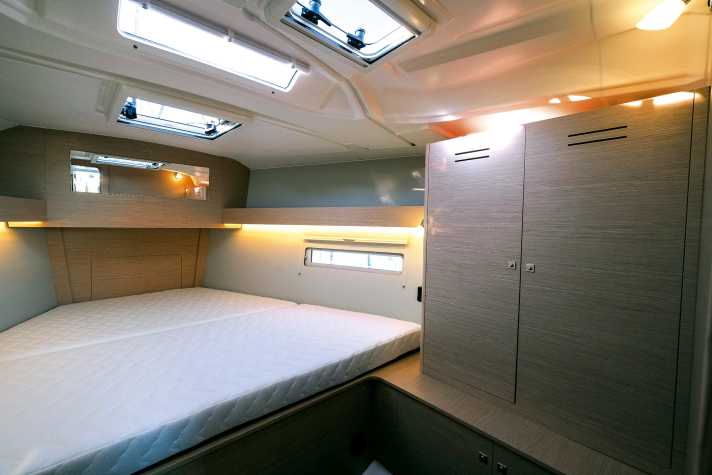
On the Hanse, the double bed in the foredeck remains the same size, whether with or without an optional bathroom. However, the berth on the boat from Greifswald is built quite far into the bow. At only 70 centimetres, it is a little cramped at the feet. Hanse also gives away valuable width at shoulder height in favour of side shelves. This looks good in the style of an island bed, but is of little use. The double berth of the Hanse is only 1.60 metres wide at the shoulders - not as much as the competition, but still comfortable, even when occupied by two people.
The aft cabins are sometimes more, sometimes less large
In the aft section, the boats from Germany retain the symmetrical layout with two cabins of equal size, separated by a technical duct, which is pleasant in terms of the acoustic separation of the compartments. Bavaria utilises the enormous projection of its stern to install two square double berths aft. However, at 1.38 metres, the width of the beds is narrow for double occupancy. On the Hanse, which is slimmer at the stern, the berths converge towards the rear, but the hull width is better utilised. The berths are 1.48 metres wide at shoulder height, which is very comfortable.
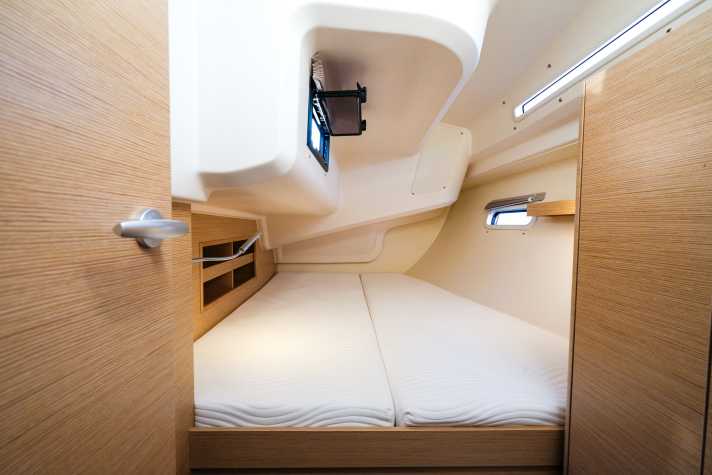
On both ships, one of the aft cabins can also be used as a forecastle ( see part 1 of the comparison test ).
The exception to the class standard is once again the Dufour. On the Frenchwoman, the two cabins in the aft ship are only separated by a simple longitudinal bulkhead, which is at the expense of privacy in the rooms, but has a positive effect on the berth dimensions. In the standard three-cabin configuration, the double beds aft with a width of 1.64 metres at the shoulders are larger than on the competitors. The Dufour test boat is the two-cabin version with a large storage space on the port side. Due to the lack of a service duct, the shipyard can flexibly design the longitudinal bulkhead in this version and extend the berth area well over the centre of the boat. In this case, you sleep aft at right angles to the direction of travel and with absolutely princely space. The width of the bed here is almost two metres.
Variance in the baths of the cruising yachts
The Bavaria has the largest toilet rooms in the comparison. On the C38, both the standard aft bathroom and the optional wet room forward are more spacious. In addition, the toilet area with shower is semi-separated, which is very pleasant. On the Hanse, the aft bathroom is similarly large and just as functional as that of the Bavaria, and is also beautifully finished, also with a partial separation. However, if the customer wants an additional WC in the foredeck, this would be very small and cramped on the Hanse - an option that needs to be carefully considered.
On the Dufour ship, the standard aft toilet is significantly smaller than that of the competition from Germany. A shower option is only available here in the form of a pull-out tap.
However, if the boats are equipped with two cabins, the tide turns. In this case, the Hanse and Dufour boats offer the option of installing an additional large shower cubicle, on the Hanse even as a separate, completely separate wet room between the galley and forecastle. Bavaria is less versatile in this respect: on the C38, the toilet room remains the same size for all variants, and there is no option for an additional fully enclosed shower cubicle.
These details are impressive on the cruising yachts
The Bavaria benefits from its more compact arrangement in the saloon in terms of the design of the galley, which is larger than on the Hanse and Dufour. In fact, the Giebelstadt-based company installed the same galley module here as on the one metre longer sister C42 and only trimmed it slightly. There are also more, larger and more usable storage spaces. What is missing, however, is a cover over the hob, which Bavaria does not offer as an option. This reduces the usable work surface compared to the competition, where flexible covers above the hob are already supplied as standard.
Dufour has found a smart solution for navigation with a lowerable chart table. The bench seat on the port side can be extended into a fully-fledged sofa berth with an inlay cushion, thus creating an additional sleeping option. On the Bavaria and Hanse boats, however, the sofa remains short and can only be used as a bunk for children.
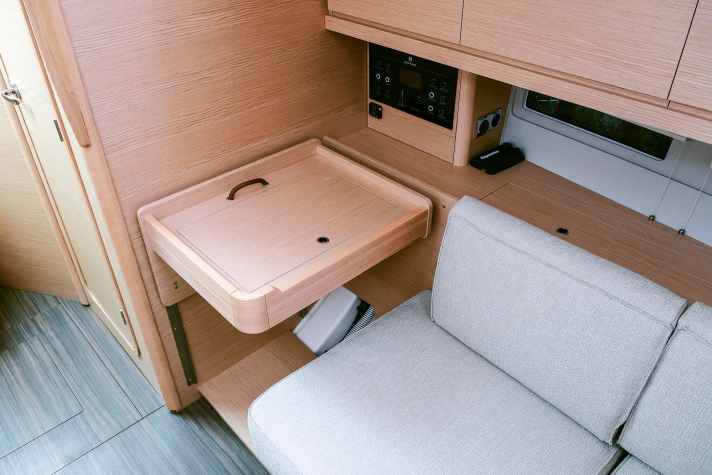
Only Bavaria and Dufour offer a lowerable saloon table for using the seating group as a double berth. Hanse, on the other hand, does not have this option in its programme.
There is no shortage of storage space on all three boats. The large lockers in all cabins, plus compartments on the sides of the saloon and underneath the sofas and berths, keep everything organised below deck. On the 390, Dufour has installed large drawers under the bench seat in the saloon so that the seat and back cushions do not have to be laboriously removed every time the storage compartments are accessed - a good solution that deserves a plus point. The Hanse 388, on the other hand, lacks open side storage compartments in the fore and aft sections, which is a pity.
Light and shade at Bavaria
The Dufour and Hanse boats offer plenty of safety at sea with solid handrails on the companionway, additional recessed grips and long handrails in the saloon along the side of the cabin superstructure. On the Bavaria C38, however, you will search in vain for a good handhold below deck. Although there is a handrail on the companionway, there are no handrails on the ceiling or at the sides, and it is also difficult to hold on to the fittings.
The boat from Giebelstadt also has to admit defeat to the competition when it comes to the electrical installations. Some of the many cables are laid loosely and confusingly and are barely labelled. Troubleshooting here would take a lot of time. The electrics on the Hanse and the Dufour are better, cleaner and easier to understand.
On the other hand, the Bavaria has the advantage of very good accessibility to the built-in engine. The components for inspection and maintenance (impeller, oil dipstick, seawater filter, etc.) are more difficult to reach on competitors' boats. And on the C38, all of the onboard outlets and valves are made of plastic, which can be seen as good and advantageous in terms of potential corrosion problems. On the two other boats, at least some of these parts are made of brass.
Finally, let's take a comparative look at the price structure. While the Bavaria C38 and the Hanse 388 are roughly on a par with gross base prices of around 210,000 euros, the Dufour 390 is almost 50,000 euros more expensive (Prices as of summer 2023), which can at least be explained to some extent by better and more complete basic equipment. The Frenchwoman is equipped with a bathing platform, a cockpit table and a long bowsprit straight from the shipyard. Bavaria and Hanse charge not inconsiderable surcharges for these components, which are basically part of a proper cruising boat anyway.
The test results for the Bavaria C38, Dufour 390 and Hanse 388
Even after a thorough check of the three comparison boats below deck and taking into account all the assessment factors from Part 1 and part 2, it is ultimately impossible to determine a clear and outstanding winner. All boats in the group test have various advantages and disadvantages - which is all well and good for healthy competition.
Ultimately, the customer must decide for themselves which concept they prefer and choose accordingly. The good thing is that they can't go wrong with any of the three boats. It's amazing how much comfort, volume, variance and sailing pleasure the leading shipyards can achieve on boats of eleven metres - and at what price. It's no wonder that many smaller manufacturers can't keep up with these very attractive offers and have to pass. So the competition is and remains small - but fine.
Living comfort in figures
Standing heights
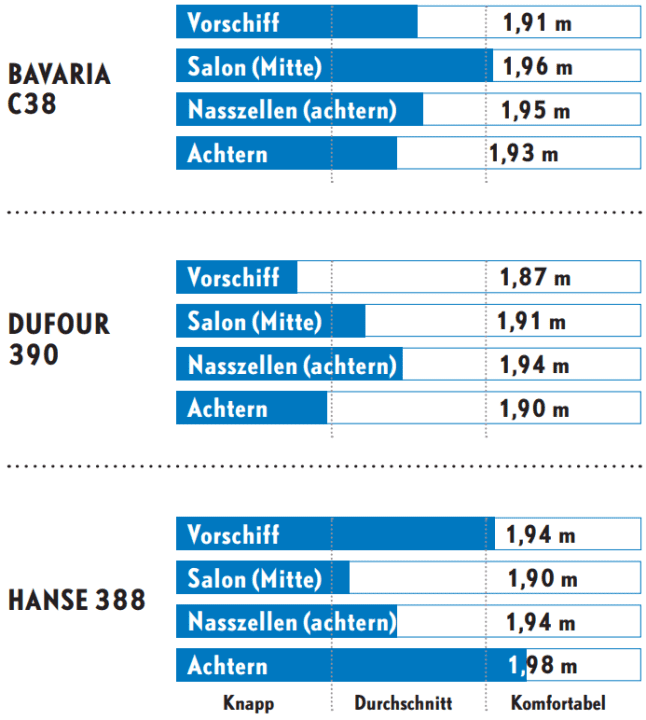
Berth dimensions
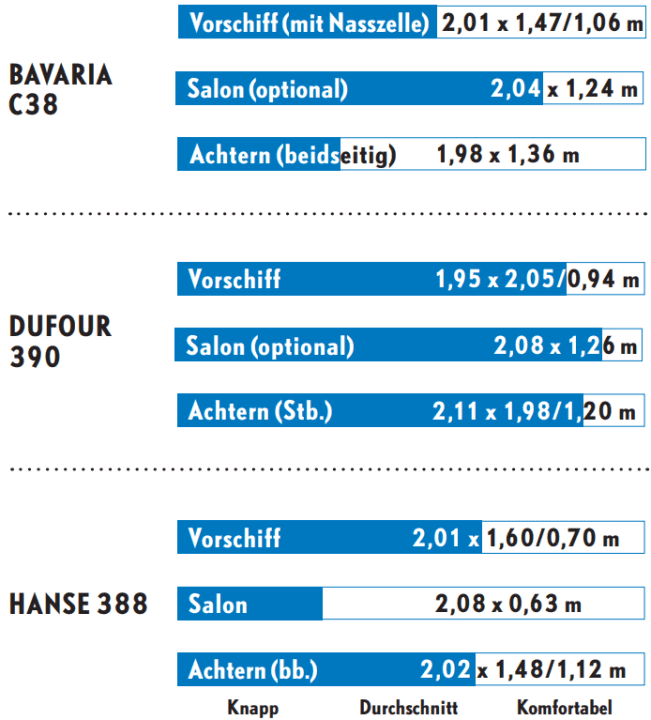
Sound level
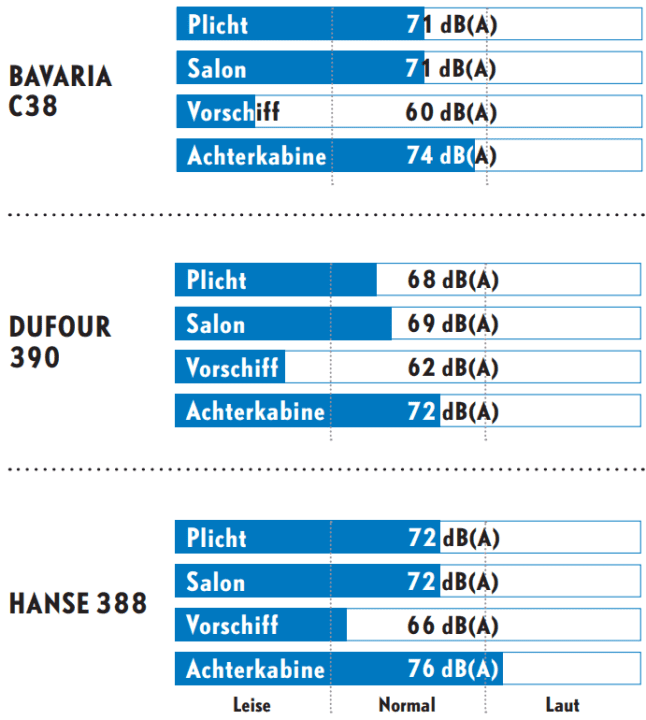
Measured at cruising speed (80% of maximum speed)
YACHT rating
Bavaria C38
Voluminous tourer from Giebelstadt with a modern, comfortable interior. The boat is somewhat less versatile than the competition in terms of its conversion options. Attractively priced
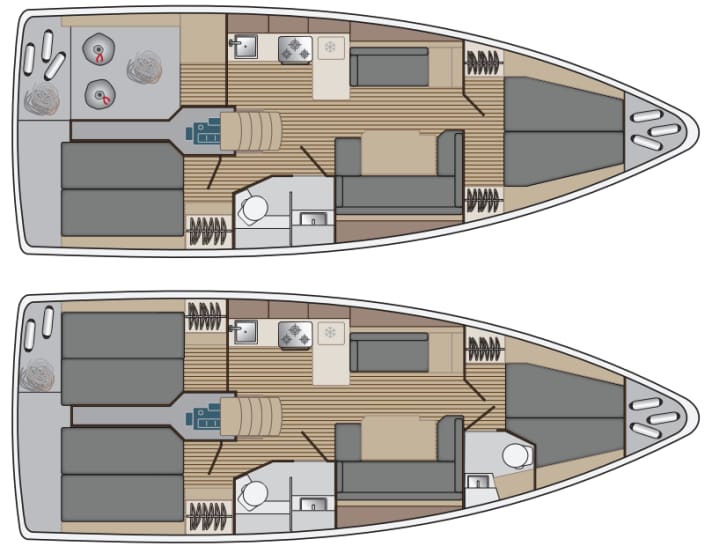
Living and finishing quality
- Large wet room, large pantry
- Widest double berth in the foredeck
- No separate shower feasible
- Berths aft rather narrow
Equipment and technology
- Generous installation of the motor
- Plastic seacocks
- Few holding options
- Messy electrical wiring
Shipyard
Bavaria Yachtbau, 97232 Giebelstadt, Germany; www.bavariayachts.com , Distribution: Dealer network
Dufour 390
The boat from France offers more variance for individual customisation requirements with up to three cabins and three wet cells. The ship is extensively equipped ex shipyard, but also costs considerably more
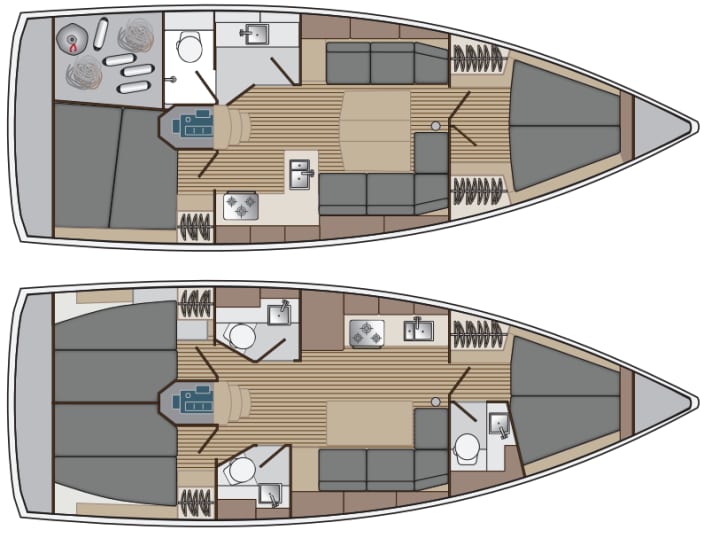
Living and finishing quality
- Lots of perceived room volume
- Widest berths aft in comparison
- Small toilet room in the standard
- Higher base price
Equipment and technology
- Lowerable card table
- Good holding options
- Improperly laid floorboards
- Little space in the engine compartment
Shipyard
Dufour Yachts, 17180 Perigny, France; www.dufour-yachts.com , Distribution: Dealer network
Hanse 388
With its very cosy and high-quality interior, the Hanse scores highly in comparison. The general concept is balanced and well thought out. And the prices are also harmonious
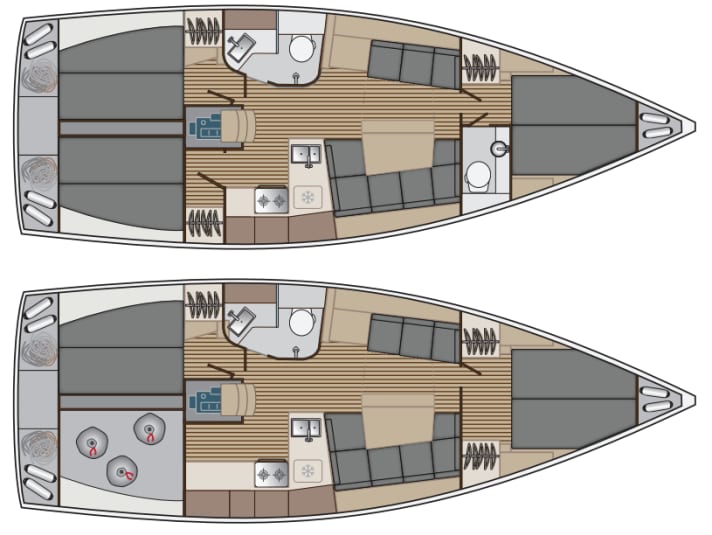
Living and finishing quality
- Cosy interior design
- Large card table
- Less storage space in the foredeck
- Front bunk less wide
Equipment and technology
- Easily accessible handrails in the salon
- Separate shower room as an option
- Cleanly installed on-board technology
- No lowerable coffee table possible
Shipyard
Hanseyachts AG, 17493 Greifswald, Germany; www.hanseyachts.de , Distribution: Dealer network
This article first appeared in YACHT 15/2021 and has been revised for this online version

